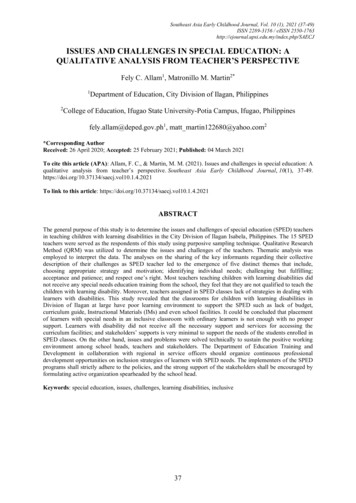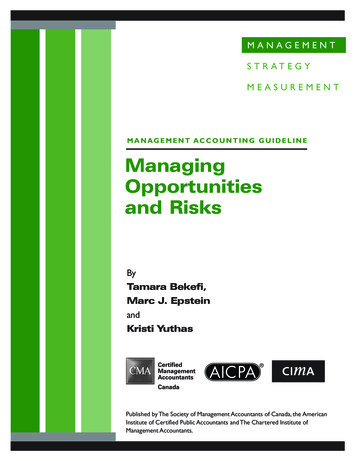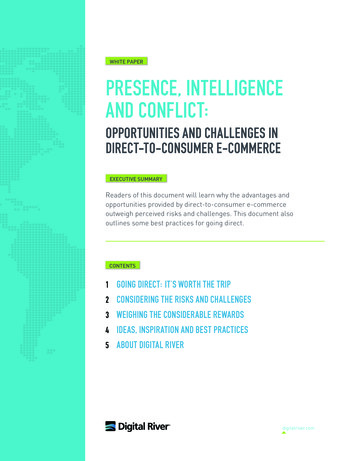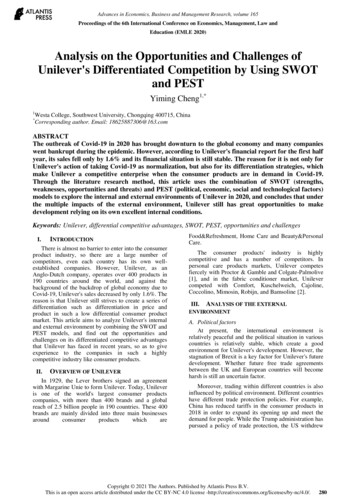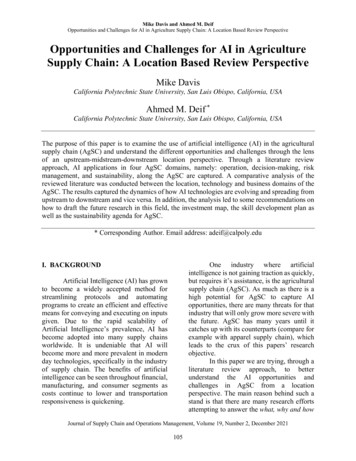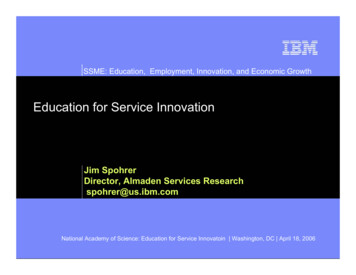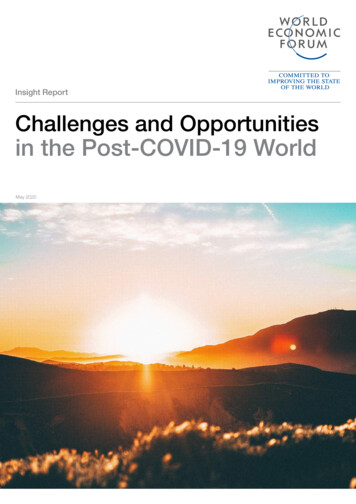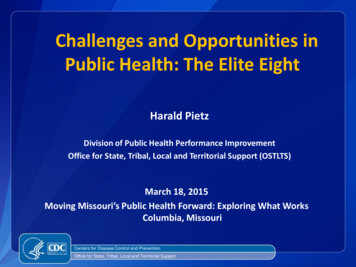
Transcription
Challenges and Opportunities inPublic Health: The Elite EightHarald PietzDivision of Public Health Performance ImprovementOffice for State, Tribal, Local and Territorial Support (OSTLTS)March 18, 2015Moving Missouri’s Public Health Forward: Exploring What WorksColumbia, MissouriCenters for Disease Control and PreventionOffice for State, Tribal, Local and Territorial Support
Emerging and Evolving PublicHealth Issues Aroundthe world Across the nation Within the federal government, HHS, CDC,OSTLTS Here in Missouri
Challenges and Opportunities forPublic Health: The Elite Eight“The best of anything considered collectively . . . ”“. . . the choice part . . . ”Direct ContributingFactorsRisk FactorsHealth PriorityIndirect ContributingFactors
The Elite Eight1. Changes in public health bring changes in publichealth standards. And vice versa.
Changes Public Health Accreditation Board (PHAB) Standards Version 1.5 Already identifying content/topics for future versions New/changing content reflecting changes in publichealth InformaticsHealth equityQuality improvement/performance managementPublic health/healthcare integrationCloser look at different settings: small/rural, tribes,territories, etc.
The Elite Eight2. Winnable battles are so named because theyare winnable.
Leading Causes of Death—US, 2011700,000Amenable to prevention interventionsaddressed by Winnable BattlesNumber of ource: National Vital Statistics Reports 2012;61(6) www.cdc.gov/nchs/data/nvsr/nvsr61/nvsr61 06.pdf
Years of Potential Life Lost forSelected Causes of Deaths—USYears of potential life lost18001600Amenable to prevention interventionsaddressed by Winnable Battles1400120010008006004002000Source: Health, United States, 2011, CDC, NCHS; Crude data for 2008, all persons, before age 75
Key Winnable Public Health Battles
Prevention Status Reports (PSRs) Goal: to help advance evidence-based public health policy andpracticeFocus is on solutions—evidence-based and expert-recommendedpublic health policies and practicesIndicators highlight the status of state-level policies and practicesIndividual reports for all 50 states and the District of Columbia on 10health topics released January 2014Projects underway: PSR Evaluation Development of the 2015PSRswww.cdc.gov/psr
The Elite Eight3. Cross-jurisdictional collaboration can be anopportunity for everyone. But it might not be foreveryone.
Cross-Jurisdictional Sharing of Public HealthServices“The deliberate exercise of public authority to enablecollaboration across jurisdictional boundaries todeliver essential public health services”Source: Center for Sharing Public Health Services. www.phsharing.org
Cross-Jurisdictional Sharing (CJS) CDC activities State, Tribal, Local, and Territorial Workgroup recommendations CDC activities and methods to foster sharing of services Collaboration and support of others (i.e., Center for Sharing PublicHealth Services and Practice-based Research Networks) www.cdc.gov/stltpublichealth/cjs Center for Sharing Public Health Services Robert Wood Johnson Foundation-supported initiative through KansasHealth Institute 16 demonstration sites across 14 states www.phsharing.org Key questions, tools, and stories
The Elite Eight4. Money makes the (public health) world go around.And the world is changing.
Financing Health and Public Health Finance questions and exploration ofcore and foundational services Foundational capabilities and foundationalareas framework and costing (RESOLVE) Reimbursement and paymentreform Finance models for community healthand prevention
Foundational Public Health Services –Conceptual Framework (RESOLVE workgroup, updated 12/2014)Programs/Activities Specific to an HD and/or Community NeedsMost of an HD’s Work is “Above the Line”FoundationalPublicHealthServices
Financing Health and Public Health Opportunities and explorations Billing for servicesHealth and wellness fundsSocial impact bondsCommunity health needs assessments (CHNAs)Cross-jurisdictional sharing
The Elite Eight5. We’ve all discussed “health in all policies.” Butwhat about “health in all partnerships?”
The Public Health System (Through Our Eyes)PoliceEMSCommunityCentersMCOs istCivic GroupsCHCsDrugTreatmentMentalHealthNursing Mass TransitHomesEnvironmentalHealthTribal ers DevelopmentFire
EPA Environmental Justice Partnership ustainability/index.html
The Appalachia Prosperity Project (APP)“A new model for economic development that values innovation,skilled labor, and a healthy workforce over physical infrastructureand commodity production . . . ”http://approject.org/about.html
The Elite Eight6. Health system transformation brings new partnersto the table. It is also creating new tables.
Achieving Health Value through theTriple AIM Triple Aim Achieve better care for patients Improve health for our communities Reduce costs through improvement in our healthcare system Emphasis on population health and payment reform Center for Medicare and Medicaid Innovation State Innovation Model Initiative (SIMs) Accountable Care Organizations Patient Centered Medical Homes
Evolution of Health SystemHealth Delivery System Transformation Critical PathEpisodic NonIntegrated CareOutcome AccountableCareLack integrated carenetworks Lack quality and costperformancetransparencyHealthy populationcentered Integrated networkslinked to communityresources capable ofaddressing psycho social/economic needs Population-basedreimbursement Patient or personcentered Transparent cost andquality performance Focus on caremanagement andpreventive care CommunityIntegrated HealthcareSource: Neal Halfon, UCLA Center for Healthier Children, Families & Communities
The Elite Eight7. In a time of needing to do more with less, it ismore important than ever not to “recreate thewheel” and to leverage connections.
Leveraging Connections Strategic and concrete links between standards, qualityimprovement, and programmatic work of public health Crosswalks with PHAB standards—The Community Guide, food safety,public health emergency preparedness capabilities, Project Public HealthReady, healthcare-associated infections, immunizations, etc. Communications Priority community issues and looking for co-benefits Leveraging connections between requirements fororganizations (e.g., CHNA)
Community Health Needs Assessment Drivers Tax-exempt hospitals and community benefit requirements for IRS(n 3,000) Federally qualified health centers (n 1,200) Federal grant requirements (e.g., Community Transformation Grant, theNational Public Health Improvement Initiative (NPHII)) Voluntary public health accreditation through PHAB (n 2,400) State laws or requirements for health departments Similar (but not the same) elements and language
The Elite Eight8. We need to always think about the “so what?”questions. Where’s the evidence? What’s the impact?What’s the return on investment?
So What? Strengthening evidence-based practice Use of evidence-based interventions (e.g., The Community Guide) Use of evaluation, performance management and qualityimprovement to drive improvements and maximize impact Strengthening practice-based evidence Peer learning and stories from the field (NPHII, PHQIX, COPPHI) Documentation—publication of practice activities Invest in strategic decision-making—cost benefit analysisand return on investment can help!
In Summary . . .1.2.3.4.5.6.7.8.Changes in public health and public health standardsWinnable battlesCross-jurisdictional collaborationHealth and public health financingPartnershipsHealth system transformationLeveraging connectionsValue, impact, and return on investment
Reactions? Questions?Additional points?
Continuing the ConversationEmail us: ostltsfeedback@cdc.govJoin us on be:www.cdc.gov/stltpublichealth
Thank you!Harald Pietz, CDC / OSTLTSHPietz@cdc.govFor more information, please contact CDC’s Office for State, Tribal, Local and Territorial Support4770 Buford Highway NE, Mailstop E-70, Atlanta, GA 30341Telephone: 1-800-CDC-INFO (232-4636)/TTY: 1-888-232-6348E-mail: OSTLTSfeedback@cdc.govWeb: http://www.cdc.gov/stltpublichealthThe findings and conclusions in this presentation are those of the authors and do not necessarily represent the official position of theCenters for Disease Control and Prevention.Centers for Disease Control and PreventionOffice for State, Tribal, Local and Territorial Support
Public Health: The Elite Eight Centers for Disease Control and Prevention Office for State, Tribal, Local and Territorial Support Harald Pietz Division of Public Health Performance Improvement Office for State, Tribal, Local and Territorial Support (OSTLTS) March 18, 2015 Moving Missouri's Public Health Forward: Exploring What Works

